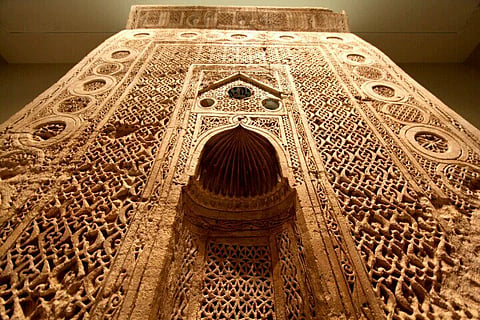Oman’s National Museum opens door to a priceless heritage
It boasts a number of firsts for the country, including a fully equipped learning centre and state-of-the-art heritage preservation facilities

Muscat: Standing next to Muscat’s iconic fortresses of Jalali and Mirani, the old Muscat Wall and Al Alam Palace, the National Museum seeks to highlight Oman’s history and culture under one roof for the first time although, on the outside, it is a state of the art building.
A stone flint believed to be two million years old — the oldest man made object found in Oman and the first throne of Sultan Qaboos Bin Saeed when took the reins in 1970 along with more than 6,000 artifacts are among the main attractions at the museum.
The National Museum, which opened on Saturday, is the first museum in the country to be established based on the International Council of Museum Standards, said Jamal Al Musawi, Acting Director General of the Museum.
Al Musawi added that it’s the only museum in the Middle East to incorporate Arabic Braille script for visually impaired visitors.
The museum was established based on the royal directives of Sultan Qaboos in 2013 and has been accorded full financial and administrative independence, according to officials. It is expected to attract thousands of visitors from within the country and outside. It will be open for visitors for four days a week (Saturday to Tuesday) until September 30, 2016.
Al Musawi explained that the entry fees will be 1 rial for Omanis and GCC nationals and 2 rials for expatriate residents and 5 rials for non-residents, adding that students up to 25 years of age of all nationalities will be exempted from entry fees whether they visit individually or in groups. Visiting hours will be from 9am to 3pm from July 30 to September 30 and the tickets will be sold up to 2.30pm only.
“The aim of the museum is to promote public awareness and activate the sense of loyalty by Omanis, expatriates and visitors,” the official said. It aims to preserve the components of Omani cultural heritage by supporting research and scientific and historical studies, and heritage conservation plans.
The museum boasts a built-up area of 13,700 square metres of which an area of 4,000 square metres is dedicated to 14 fixed display halls, including The Land and the People, Maritime History, Arms and Armour, Civilisation in the Making, Aflaj, Currency, Timeline, Prehistory and Ancient History: Bat, Al Khutm and Al Ayn; Prehistory and Ancient History: Land of Frankincense; Prehistory and Ancient History, Splendours of Islam, Oman and the World, the Renaissance, Intangible Heritage.
The museum has a number of firsts to its credit, including a fully equipped learning centre, and a state-of-the-art heritage preservation facilities that have been designed as per International Council of Museums Standards. The number of exhibits on display at the museum is 5,466 and some 7,117 items still to be displayed. The museum has put in place preservation programmes for the exhibits since 2010.
Cultural experts and historians believe that the museum will give an opportunity for Omanis and non-Omanis to learn more about ancient Omani civilisation.
Naser Al Hashemi, an Omani historian and author, told Gulf News that intangible cultural heritage in Oman has received significant attention from Sultan Qaboos and has been promoted as a pillar of Omani national identity.
“The National Museum projects the Omani national identity and the long history of the Omani civilisation and the diverse roles played by Oman,” said Al Hashemi.
Ahmad Al Mashani, a cultural expert, says that Oman has had other museums since 1970s, but the latest one is different. “The difference is that this museum is more integral, majestic and has more priceless artifacts that precisely narrate the Omani history.”
Shaikha Al Jasasi, an Omani who has a sizeable following on twitter, said that she expressed her gratitude for the museum’s initiative to incorporate Arabic braille script for the benefit of visually impaired visitors.
“Me like other visually impaired visitors can enjoy and know more about Oman’s rich history,” said Al Jasasi.
Ahmad Al Mamari, a teacher at a government school, told Gulf News that the museum would help enrich the knowledge of Omani school students as it has an integral educational centre for children of all age groups.
“A hall has been designated for only children to practice their own hobbies in the museum like drawing and educational games,” said Al Mamari.
AL Mamari explained that the museum will enable Omani children to know more about their rich culture and the old Omani empire.
Juma Al Hasni, a longtime Muscat resident, told Gulf News that he felt very proud since the museum was very close to his home. “Its only 50 metres distance from my house. I can’t wait to go and pay a visit for the museum,” he said.
The number of visitors to the Omani museums stood at 253,252 in 2015, compared to 250,283 visitors in 2014, according to the National Centre for Statistics and Information.
Other museums in the country include the Armed-Forces Museum, Bait Al Barandah Museum, Bait Al Zubair Museum, Children’s Museum, Ecology Oman Centre, Land of Frankincense Museum, Maritime Museum, Muscat Gate Museum, Natural History Museum, Old Castle Museum, Omani Museum, Omani-French Museum, Sohar Fort Museum, Turtles Museum and the Currency Museum.
Sign up for the Daily Briefing
Get the latest news and updates straight to your inbox


